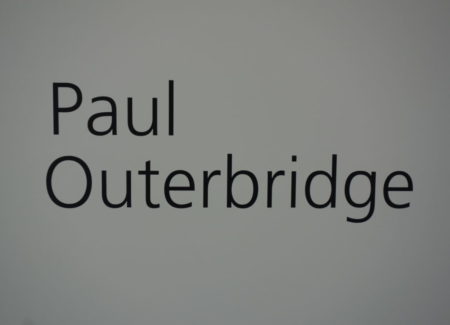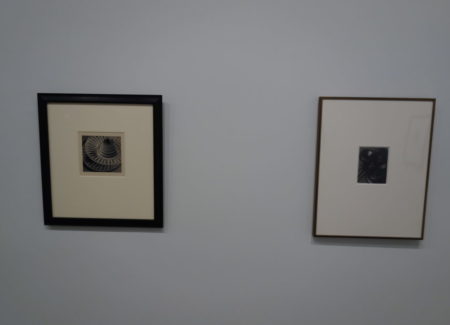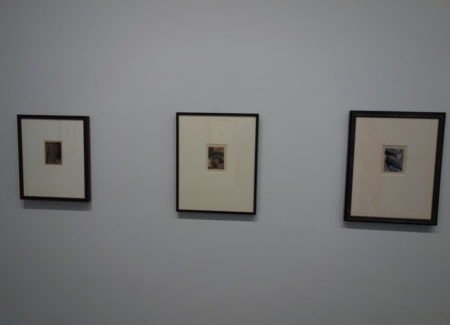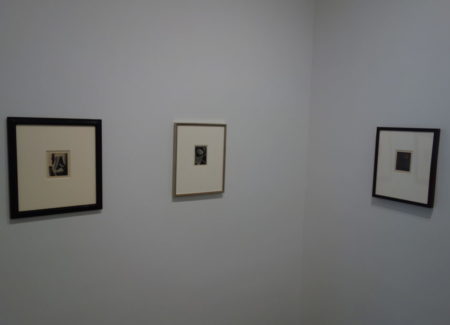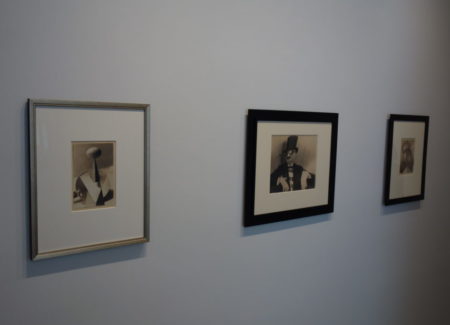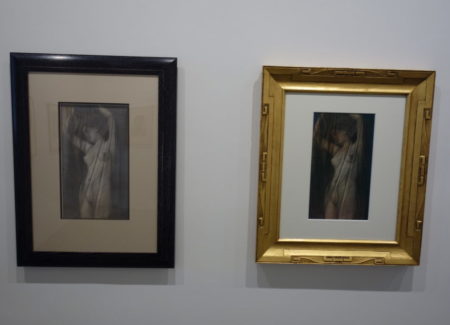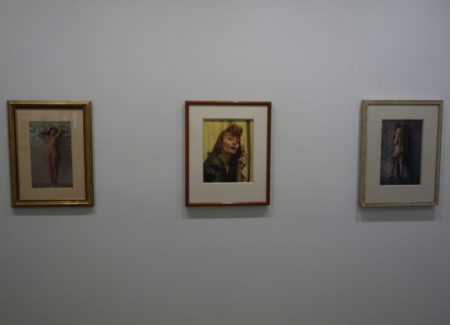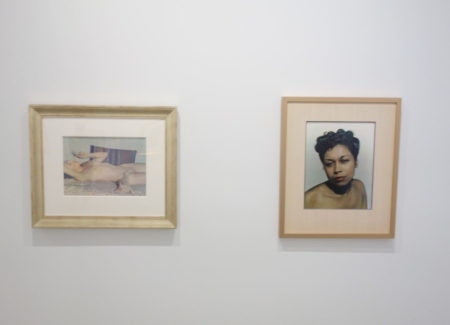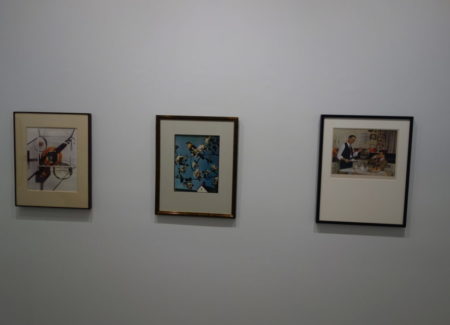JTF (just the facts): A total of 41 black and white and color photographs, variously framed and matted, and hung in the main gallery space, the smaller front room, and the reception area. The works were made between 1918 and 1941 and were executed using a range of photographic processes: bromide, gelatin silver, platinum, platinum-palladium, waxed platinum, toned gelatin silver, and carbro. Physical sizes range from roughly 5×4 to 18×12 (or reverse). (Installation images below.)
Comments/Context: It’s hard to believe that it’s been nearly 40 years since Paul Outerbridge’s work had a proper retrospective showing here in New York, as the innovations of this influential photographic master seem particularly relevant to contemporary audiences. While this museum-quality survey provides a well-edited chronological sampler of his early Pictorialist studies, superlative Modernist still lifes, surreal portraits, and lushly textural nudes, it’s Outerbridge’s sophisticated interaction with the visual codes of advertising and his meticulous use of various photographic processes that will resonate most strongly with today’s viewers. He had the unique ability to create knowingly sleek arrangements of objects that straddled art and commerce, their exacting perfection threatening to topple over into staged irony and fetishized ardor, and that uneasy tension is what gives his images their durable vitality.
Outerbridge’s still life studies from the early 1920s show him optimizing his compositional control. Workshop scenes like a bucket on a ladder or a metal saw laid across a wooden box offered nearly endless combinations of geometric lines and angles, the sublime richness of his platinum prints giving his setups a burnished glow. The kitchen was equally fertile territory, where a pair of eggs in a pie tin or several artfully clustered near a bowl of milk provided opportunities to consider shadow, reflection, and formal balance. Even the rounded curves of an ordinary black bakelite telephone could be seductive in his hands, with highlights and circular echoes combining to create an almost futuristic optimism.
Other still lifes from this same period of Modernist precision seem to edge closer to product-shot advertising, often introducing an undercurrent of readymade Dada oddity or found elegance into the mood. His close-up of the machined edges of a Marmon crankshaft exudes powerful industrial romance, while his blob of wiggly layered Jell-O on a striped dish feels like a homemaker’s dream of dessert perfection, with the radiating lines of the plate echoed by the lines in the gelatin. Two images of men’s accoutrements give stylish simplicity a twist, with a striped silk tie decorated by a pearl tie pin transformed into a study of tonal shading, and the arc of a crisply starched white collar given object centrality against a bold checkerboard backdrop (Duchamp apparently kept a print of this work tacked to the wall of his studio). And an image from just a few years later would push further toward flights of staged fantasy, a composition built from a lacy diamond encrusted mask and a pair of zig zag bracelets introducing a picture within a picture to skew the flat background.
Outerbridge’s nudes go through several stages of transformation during the 1920s and 1930s. His early examples are largely exercises in texture, using the richness of the platinum process to capture skin surfaces – cropped down bodies recede into the warm caramel color of the process as though enveloped in misty indistinctness. But that muted conservatism quickly gives way to more overt eroticism, particularly in a 1927 image of the lower half of a woman in thigh-high stockings and sparkly heels, surrounded by wilted flower petals. By the mid-193s, Outerbridge’s nudes are both more confidently playful and more strongly keyed into desire, from a nude woman lounging and smoking a cigarette with a kitten frolicking near her midsection and a number of nudes with raised arms, to a seated nude in bright red shoes and his iconic 1936 Nude with Mask and Hat, where a bathing cap, patent leather gloves, and one stocking add to the fetish motif.
All of Outerbridge’s later nudes pop with the distinctive color of the arduous three-color carbro process, giving them a surge of off-kilter energy that enhances the deliberate intermingling of visual cues taking place. This signature process did even more for Outerbridge’s mid-1930s still lifes and advertising scenes, enriching them with a tingling feeling of heightened reality, creating color that feels both strange and wonderful. A kitchen canning setup feels overfilled with color details, from apples and a sliced watermelon to rows of glass jars and a fly swatter. His beach scene is dominated by the bright orange stripes of an umbrella, the chaise and picnic basket arranged in a kind of otherworldly perfection we now associate with Martha Stewart. With a gold cone, a red ball, and a folding ruler, he turns an ad for Cinzano vermouth into an homage to Kandinsky, and a surging backdrop of cherry red surrounds us as he brings us almost inside the sparkly center of a Christmas ornament. Perhaps the goofiest of the images on view is a staged kitchen scene where a mischievous father and son munch on doughnuts and milk after mother has gone to bed, her joking note “Prowlers Welcome” pinned to the cabinet – it’s a Norman Rockwell setup, slightly unhinged.
This survey is certainly among the best gallery shows of vintage photography we are going to see in New York this year. With just once glance through this deep selection of works, it’s easy to see how Outerbridge’s trailblazing stylistic influence has percolated through the medium, from encouraging artists like Robert Mapplethorpe and Helmut Newton to sparking more recent explorers of the borderlands between commercial and fine art imagery like Roe Ethridge and Elad Lassry. As seen here, the exacting power of Outerbridge’s compositions is still as freshly smart and pleasingly challenging as ever, subtly leveraging the conventions of advertising to repeatedly upend our expectations.
Collector’s POV: Most of the prints in this show are on loan, and are accordingly NFS. The ones that are for sale range in price from $35000 to $295000. Outerbridge’s work is consistently available in the secondary markets, with recent prices ranging from roughly $5000 to $375000.
